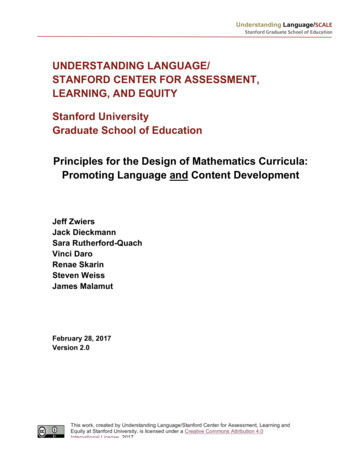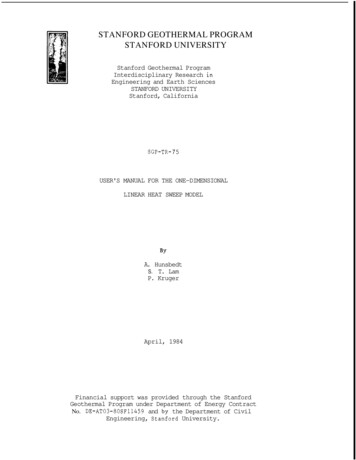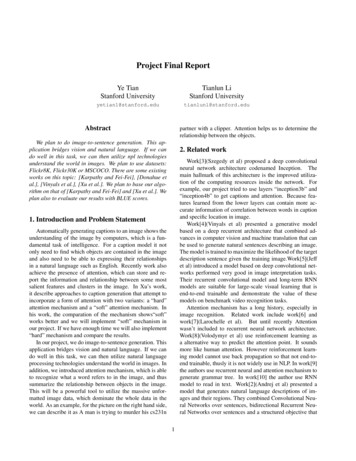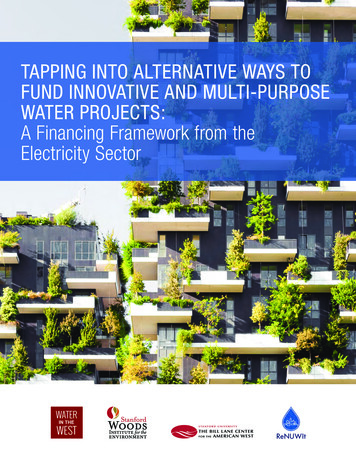
Transcription
Understanding Language/SCALEStanford Graduate School of EducationUNDERSTANDING LANGUAGE/STANFORD CENTER FOR ASSESSMENT,LEARNING, AND EQUITYStanford UniversityGraduate School of EducationPrinciples for the Design of Mathematics Curricula:Promoting Language and Content DevelopmentJeff ZwiersJack DieckmannSara Rutherford-QuachVinci DaroRenae SkarinSteven WeissJames MalamutFebruary 28, 2017Version 2.0This work, created by Understanding Language/Stanford Center for Assessment, Learning andEquity at Stanford University, is licensed under a Creative Commons Attribution 4.0International License. 2017.
Understanding Language/SCALEStanford Graduate School of EducationAcknowledgementsThe authors wish to express their gratitude to several colleagues who contributed greatlyto this project. First and foremost, we would like to thank Kenji Hakuta for his dedicationand guidance. Without his leadership and commitment this project would not have beenpossible. The project also benefitted from the discussions, iterative feedback cycles, andgeneral support provided by Maura Dudley, Rebecca Bergey, and Magda Chia.Resources produced by UL/SCALE at Stanford University are available electronically athttp://ell.stanford.edu.Recommended citation:Zwiers, J., Dieckmann, J., Rutherford-Quach, S., Daro, V., Skarin, R., Weiss, S., &Malamut, J. (2017). Principles for the Design of Mathematics Curricula:Promoting Language and Content Development. Retrieved from StanfordUniversity, UL/SCALE s-resources-additional-resourcesThis work, created by Understanding Language/Stanford Center for Assessment, Learning andEquity at Stanford University, is licensed under a Creative Commons Attribution 4.0International License. 2017.2
Understanding Language/SCALEStanford Graduate School of EducationOVERVIEWThe purpose of this document is to nudge the field forward by offering support tothe next generation of mathematics learners and by challenging persistent assumptionsabout how to support and develop students’ disciplinary language. Our goal is to provideguidance to mathematics teachers for recognizing and supporting students' languagedevelopment processes in the context of mathematical sense making. We provide aframework for organizing strategies and special considerations to support students inlearning mathematics practices, content, and language. The framework is intended to helpteachers address the specialized academic language demands in math when planningand delivering lessons, including the demands of reading, writing, speaking, listening,conversing, and representing in math (Aguirre & Bunch, 2012). Therefore, while theframework can and should be used to support all students learning mathematics, it isparticularly well-suited to meet the needs of linguistically and culturally diverse studentswho are simultaneously learning mathematics while acquiring English.OUR THEORY OF ACTIONSystemic barriers for language learners persist not only in tasks and materials, butin educators’ presentational language, expectations for peer interactions, and assessmentpractices. Only through intentional design of materials, teacher commitments,administrative support, and professional development can language development be builtinto teachers’ instructional practice and students’ classroom experience. Our theory ofaction for this work is grounded in the interdependency of language learning anddisciplinary learning, the central role of student agency in the learning process, theimportance of scaffolding routines that foster students’ independent participation, andthe value of instructional responsiveness in the teaching process.Mathematical understandings and language competence developinterdependently. Deep disciplinary learning is gained through language, as it is theprimary medium of school instruction (Halliday, 1993). Ideas take shape multi-modally,through words, texts, illustrations, conversations, debates, examples, etc. Teachers,peers, and texts serve as language resources for learning (Vygotsky, 1978). Contentteachers (implicitly/explicitly) teach the language of their discipline. Instructional attentionto this language development, historically limited to vocabulary instruction, has nowshifted to also include instruction around the demands of argumentation, explanation,analyzing purpose and structure of text, and other disciplinary discourse.Students are agents in their own mathematical and linguistic sense-making. Oneprevailing assumption is that mathematical language proficiency means using only formaldefinitions and vocabulary. Although that is how math is often more formally presented intextbooks, this type of language does not reflect the process of exploring and learningThis work, created by Understanding Language/Stanford Center for Assessment, Learning andEquity at Stanford University, is licensed under a Creative Commons Attribution 4.0International License. 2017.3
Understanding Language/SCALEStanford Graduate School of Educationmathematics. Another common assumption is that developing the language of thediscipline requires continuous “time-outs” from the content, and multiple detours into “mathlanguage” mini-lessons. However, through successive and supportive experiences withmath ideas, learners make sense of math with their existing language toolkit(Moschkovich, 2012), while also expanding their language repertoire with tools andmathematics conventions as they come to see these tools (e.g., definitions, properties,procedures) as useful in accomplishing a meaningful goal.1We challenge both of these assumptions because we see “language as action” ( van Lier& Walqui, 2012): in the very doing of math, students have naturally occurring opportunitiesto learn and notice mathematical ways of making sense and talking about ideas and theworld. It is our responsibility as educators to structure, highlight, and bolster theseopportunities, making explicit the many different ways that mathematical ideas arecommunicated, rather than acting as “the keepers’” or “the givers” of language. Acommitment to help students develop their own command of the “mathematical register” istherefore not an additional burden on teachers, but already embedded in a commitment tosupporting students to become powerful mathematical thinkers and ‘do-ers’ (Lee, Quinn &Valdés, 2013).Scaffolding provides temporary supports that foster student autonomy. Someeducators hold a more traditional assumption that students will learn the Englishlanguage and disciplinary language by merely being immersed in them over time, withlittle additional support. This presents serious equity and access issues that cannot gounchallenged. Disciplinary language development occurs when students use theirdeveloping language to make meaning and engage with challenging disciplinary contentunderstandings that are beyond students’ mathematical ability to solve independently.However, these tasks should include temporary supports that students can use to makesense of what is being asked of them and to organize their thinking. Learners withemerging language – at any level – can engage deeply with central disciplinary ideasunder specific instructional conditions (Walqui & van Lier, 2010). Temporary supports, orscaffolds, can include teacher modeling, supporting students in making charts withmathematical information from a word problem, providing manipulatives or graphicorganizers to support sense-making, identifying and drawing upon students’ innerresources, and structured peer interactions. Immediate feedback from intentionallydesigned peer interaction helps students revise and refine not only the way theyorganize and communicate their own ideas, but also the way they ask questions toclarify their understandings of others’ ideas.1A meaningful goal might be explaining a problem solving technique, modeling a solution, orjustifying an argument.This work, created by Understanding Language/Stanford Center for Assessment, Learning andEquity at Stanford University, is licensed under a Creative Commons Attribution 4.0International License. 2017.4
Understanding Language/SCALEStanford Graduate School of EducationInstruction supports learning when teachers respond to students’ verbal andwritten work. The mathematics language routines described later in this document helpboth teachers and students keep one eye and ear on language as much as possible,focusing attention to student language that support in-the-moment teacher, peer, and selfassessment (Cazden, 2001). Teachers can adapt and respond more effectively to whatstudents are saying and doing as they develop disciplinary language and contentunderstanding concurrently.Based on their observations of student language, teachers can make adjustments to theirteaching and provide additional language scaffolding where necessary. Teachers canselect from the “heavier” or “lighter” supports provided in the curriculum as appropriate.When selecting from these supports, teachers should take into account the languagedemands of the task in relation to their students’ English language proficiency.OUR FRAMEWORKThis framework includes four design principles for promoting mathematicallanguage use and development in curriculum and instruction. The design principles andrelated routines work to make language development an integral part of planning anddelivering instruction while guiding teachers to amplify the most important language thatstudents are expected to bring to bear on the central mathematical ideas of each unit. Thedesign principles, elaborated below, are:Design Principle 1: Support sense-makingDesign Principle 2: Optimize outputDesign Principle 3: Cultivate conversationDesign Principle 4: Maximize linguistic and cognitive meta-awarenessThese four principles are intended as guides for curriculum development and planning andexecution of instruction, including the structure and organization of interactiveopportunities for students, and the observation, analysis, and reflection on studentlanguage and learning. The design principles motivate the use of mathematical languageroutines, described in detail below, with examples. The eight routines included in thisdocument are:MLR1: Stronger and Clearer Each TimeMLR2: Collect and DisplayMLR3: Critique, Correct, and ClarifyMLR4: Information GapMLR5: Co-Craft Questions and ProblemsMLR6: Three ReadsMLR7: Compare and ConnectThis work, created by Understanding Language/Stanford Center for Assessment, Learning andEquity at Stanford University, is licensed under a Creative Commons Attribution 4.0International License. 2017.5
Understanding Language/SCALEStanford Graduate School of EducationMLR8: Discussion --------------DESIGN PRINCIPLES FOR PROMOTING MATHEMATICAL LANGUAGE USE ANDDEVELOPMENT IN CLASSROOMSPrinciple 1SUPPORT SENSE-MAKING: Scaffold tasks and amplify language so studentscan make their own meaning.Students do not need to understand a language completely before they can startmaking sense of academic content and negotiate meaning in that language. Languagelearners of all levels can and should engage with grade-level content that is appropriatelyscaffolded. Students need multiple opportunities to talk about their mathematical thinking,negotiate meaning with others, and collaboratively solve problems with targeted guidancefrom the teacher (Cazden, 2001; Moschkovich, 2013). In addition, teachers can fosterstudents’ sense-making by amplifying rather than simplifying, or watering down, their ownuse of disciplinary language.Teachers should make language more “considerate” to students by amplifying(Walqui & van Lier, 2010) rather than simplifying speech or text. Simplifying includesavoiding the use of challenging texts or speech. Amplifying means anticipating wherestudents might need support in understanding concepts or mathematical terms, andproviding multiple ways to access those concepts and terms. For example, organizinginformation in a clear and coherent way, providing visuals or manipulatives, modelingproblem-solving, engaging in think-alouds, creating analogies or context, and layeringmeaning are all ways to amplify teacher language so that students are supported in takingan active role in their own sense-making of mathematical relationships, processes,concepts and terms.Several routines can be used to Support Sense-Making. In particular, MLR2 - Collect andDisplay, MLR6 – Three Reads, and MLR8 – Discussion Supports.Principle 2OPTIMIZE OUTPUT: Strengthen the opportunities and supports for helpingstudents to describe clearly their mathematical thinking to others, orally,visually, and in writing.This work, created by Understanding Language/Stanford Center for Assessment, Learning andEquity at Stanford University, is licensed under a Creative Commons Attribution 4.0International License. 2017.6
Understanding Language/SCALEStanford Graduate School of EducationLinguistic output is the language that students use to communicate their ideas toothers. Output can come in various forms, such as oral, written, visual, etc. and refers toall forms of student linguistic expressions except those that include significant back-andforth negotiation of ideas. (That type of conversational language is addressed in the thirdprinciple.)Students need repeated, strategic, iterative and supported opportunities toarticulate complex mathematical ideas into words, sentences, and paragraphs (Mondada,2004). They need spiraled practice in (a) making their ideas stronger with more robustreasoning and examples, and (b) making their ideas clearer with more precise languageand visuals. They need to make claims, justify claims with evidence, make conjectures,communicate their reasoning, critique the reasoning of others, and engage in othermathematical practices. Increasing the quality and quantity of opportunities to describemathematical reasoning also will allow teachers to frequently formatively assess students’content learning and language use so that teachers can provide feedback and differentiateinstruction more effectively.Several routines can be used to Optimize Output. In particular, MLR1 – Stronger andClearer, MLR3 – Critique, Correct, and Clarify, MLR4 – Info Gap, MLR5 – Co-craftQuestions and Problems, and MLR7 – Compare and Connect.Principle 3CULTIVATE CONVERSATION: Strengthen the opportunities and supports forconstructive mathematical conversations (pairs, groups, and whole class).Conversations are back-and-forth interactions with multiple turns that build upideas about math. Conversations act as scaffolds for students developing mathematicallanguage because they provide opportunities to simultaneously make meaning andcommunicate that meaning (Mercer & Howe, 2012; Zwiers, 2011). They also allowstudents to hear how other students express their understandings. When students have areason or purpose to talk and listen to each other, interactive communication is moreauthentic. For example, when there is an “information gap,” in which students need orwant to share their thoughts (which are not the same), students have a reason or purposein talking and listening to each other.During effective discussions, students pose and answer questions, clarify what isbeing asked and what is happening in a problem, build common understandings, andshare experiences relevant to the topic. As mentioned in Principle 2, learners must besupported in their use of language, including within conversations, to make claims, justifyclaims with evidence, make conjectures, communicate reasoning, critique the reasoning ofThis work, created by Understanding Language/Stanford Center for Assessment, Learning andEquity at Stanford University, is licensed under a Creative Commons Attribution 4.0International License. 2017.7
Understanding Language/SCALEStanford Graduate School of Educationothers, and engage in other mathematical practices – and above all, to make mistakes.Meaningful conversations depend on the teacher using lessons and activities asopportunities to build a classroom culture that motivates and values efforts tocommunicate.Many routines can be used to Cultivate Conversation. In particular, MLR1 – Stronger andClearer, MLR3 – Critique, Correct, and Clarify, MLR4 – Info Gap, MLR5 – Co-craftQuestions and Problems, MLR7 – Compare and Connect, and MLR8 – DiscussionSupports.Principle 4MAXIMIZE META-AWARENESS: Strengthen the ”meta-” connections anddistinctions between mathematical ideas, reasoning, and language.Language is a tool that not only allows students to communicate their mathunderstanding to others, but also to organize their own experience, ideas, and learning forthemselves. Meta-awareness is consciously thinking about one's own thought processesor language use. Meta-awareness develops when students and teachers engage inclassroom activities or discussions that bring explicit attention to what students need to doto improve communication and/or reasoning about mathematical concepts. When studentsare using language in ways that are purposeful and meaningful for themselves, in theirefforts to understand – and be understood by – each other, they are motivated to attend toways in which language can be both clarified and clarifying (Mondada, 2004).Meta-awareness in students is strengthened when, for example, teachers askstudents to explain to each other the strategies they brought to bear to solve a challengingmulti-step problem. They might be asked, “How does yesterday’s method connect with themethod we are learning today?,” or, “What ideas are still confusing to you?” Thesequestions are metacognitive because they help students to reflect on their own andothers’ learning of the content. Students can also reflect on their expanding use oflanguage; for example, by comparing the differences between how an idea is expressed intheir native language and in English. Or by comparing the language they used to clarify aparticularly challenging mathematics concept with the language used by their peers in asimilar situation. This is called metalinguistic because students reflect on English as alanguage, their own growing use of that language, as well as on particular ways ideas arecommunicated in mathematics. Students learning English benefit from being aware of howlanguage choices are related to the purpose of the task and the intended audience,especially if an oral or written report is required. Both the metacognitive and themetalinguistic are powerful tools to help students self-regulate their academic learning andlanguage acquisition.This work, created by Understanding Language/Stanford Center for Assessment, Learning andEquity at Stanford University, is licensed under a Creative Commons Attribution 4.0International License. 2017.8
Understanding Language/SCALEStanford Graduate School of EducationMany routines can be used to develop and formatively assess students’ meta-cognitiveand meta-linguistic awareness. In particular, MLR2 - Collect and Display, MLR3 – Critique,Correct, and Clarify, MLR5 – Co-craft Questions and Problems, MLR6 – Three Reads,MLR7 – Compare and Connect, and MLR8 – Discussion Supports, lend themselves wellto having students place extra attention on the language used to engage in mathematicalcommunication and reasoning.MATHEMATICAL LANGUAGE ROUTINESThe following mathematical language development routines were selectedbecause they are the most effective and practical for simultaneously learningmathematical practices, content, and language. These routines also can be used in mostlessons and across grade levels. A 'math language routine' refers to a structured butadaptable format for amplifying, assessing, and developing students' language. Theroutines emphasize the use of language that is meaningful and purposeful, not inauthenticor simply answer-based. These routines can be adapted and incorporated across lessonsin each unit to fit the mathematical work wherever there are productive opportunities tosupport students in using and improving their English and disciplinary language.These routines facilitate attention to student language in ways that support in-themoment teacher-, peer-, and self- assessment. The feedback enabled by these routineswill help students revise and refine not only the way they organize and communicate theirown ideas, but also ask questions to clarify their understandings of others’ ideas.Mathematical Language Routine 1: Stronger and Clearer Each TimePurpose: To provide a structured and interactive opportunity for students torevise and refine both their ideas and their verbal and written output (Zwiers,2014). This routine provides a purpose for student conversation as well as fortifiesoutput. The main idea is to have students think or write individually about aresponse, use a structured pairing strategy to have multiple opportunities to refineand clarify the response through conversation, and then finally revise their originalwritten response. Throughout this process, students should be pressed for details,and encouraged to press each other for details. Subsequent drafts should showevidence of incorporating or addressing new ideas or language. They should alsoshow evidence of refinement in precision, communication, expression, examples,and/or reasoning about mathematical concepts.Example 1 – Successive Pair Shares1. PRE-WRITE: Have students, individually, look at a problem and write downThis work, created by Understanding Language/Stanford Center for Assessment, Learning andEquity at Stanford University, is licensed under a Creative Commons Attribution 4.0International License. 2017.9
Understanding Language/SCALEStanford Graduate School of Education2.3.4.5.6.their idea/reasoning for solving the problem a certain way, or any thoughtsor questions about it, in complete sentences if possible. This is the pre-writesample; there will be a post-write to see if the sharing with others makes adifference. [Optional scaffold: Provide part of an initial draft for students tobegin with that contains the language needed for an important idea.]THINK TIME: Then give a minute for students to think about what they willsay to the first partner to explain what they are doing, or did, to solve it.(They can’t look at what they wrote while talking).STRUCTURED PAIRING: Use a successive pairing structure. (Forexample: Have students get into groups of 6 or 8, with inner circles of 3 or 4facing outer circles of 3 or 4). Remind students that oral clarity andexplaining reasoning are important. Even if they have the right answer orthey both agree, the goal is either (1) to be able to clearly explain it to othersas a mathematician would or (2) for the other person to truly understand thespeaker’s ideas. Goal (1) is appropriate when students are further along inthe development of a concept; goal (2) is appropriate closer to whenstudents are first introduced to a concept.IN PAIRS: When one partner is listening, he or she can ask clarifyingquestions, especially related to justifying (Why did you do that?). The otherperson then also shares and the listener also asks clarifying questions todraw more language and ideas out of quiet partners, if needed.SWITCH: Partners switch one, two, or three more times, strengthening andclarifying their idea each time they talk to a new partner. Optionally, turnscan emphasize strength (focus on math concepts and skills) or clarity (howto describe the math to others). Scaffolds can be removed with eachsuccessive pairing to build student independence.POST-WRITE: Have students return to seats and write down their finalexplanations, in sentences (they can use drawings, too, explained bysentences). Turn in.Example 2 – Convince Yourself, a Friend, a SkepticStudents create three iterations of a mathematical argument or justification forthree different audiences.1. For the first draft, students explain or justify their argument in whatever wayinitially makes sense to them.2. In the second draft, students are encouraged to explain WHAT they knowand HOW they know it is true. Their explanations should include words,pictures, and numbers. They trade their written arguments with a peer whoacts as a “friend” giving feedback on these components (WHAT and HOW).3. In the third draft, students are encouraged to explain WHY what they know isThis work, created by Understanding Language/Stanford Center for Assessment, Learning andEquity at Stanford University, is licensed under a Creative Commons Attribution 4.0International License. 2017.10
Understanding Language/SCALEStanford Graduate School of Educationtrue by supporting their claims with evidence. Their explanations shouldinclude words, pictures, numbers, and examples. They should includeexamples that look like they might not be true but actually are. They shouldanticipate and address counter-arguments. They trade their writtenarguments with a peer who acts as a “skeptic” giving feedback on thesecomponents (WHY, examples, counter-arguments).Mathematical Language Routine 2: Collect and DisplayPurpose: To capture students’ oral words and phrases into a stable, collectivereference. The intent of this routine is to stabilize the fleeting language that studentsuse in order for their own output to be used as a reference in developing theirmathematical language. The teacher listens for, and scribes, the language studentsuse during partner, small group, or whole class discussions using written words,diagrams and pictures. This collected output can be organized, revoiced, or explicitlyconnected to other language in a display that all students can refer to, build on, ormake connections with during future discussion or writing. Throughout the course ofa unit, teachers can reference the displayed language as a model, update and revisethe display as student language changes, and make bridges between studentlanguage and new disciplinary language. This routine provides feedback for studentsin a way that increases sense-making while simultaneously supporting metaawareness of language.Example 1 – Gather and Show Student Discourse (Dieckmann, 2017)During pair/group work, circulate and listen to student talk during pair work orgroup work, and jot notes about common or important words and phrases,together with helpful sketches or diagrams. Scribe students’ words andsketches on visual display to refer back to during whole class discussionsthroughout the unit. Refer back to these words, phrases, and diagrams byasking students to explain how they are useful, asking students to clarify theirmeaning, and asking students to reflect on which words and visuals help tocommunicate ideas more precisely.Example 2 – Number Talks (Humphreys & Parker, 2015)1. INDEPENDENT THINK: Present students with a numeracy problem to besolved without paper for 1-2 minutes2. WHOLE CLASS SHARE-OUT: Have students share the method or strategythey used to arrive at an answer3. DISPLAY STUDENT IDEAS: As students share their strategies, create avisual display for each of their methods or have students create their ownThis work, created by Understanding Language/Stanford Center for Assessment, Learning andEquity at Stanford University, is licensed under a Creative Commons Attribution 4.0International License. 2017.11
Understanding Language/SCALEStanford Graduate School of Educationvisual displays4. ASK PROBING QUESTIONS: Ask students to compare and contrast thedisplayed methods (See MLR7), the benefits and drawbacks of displayedmethods in different contexts, and/or to apply a certain student’s method to anew problem.Mathematical Language Routine 3: Critique, Correct, and ClarifyPurpose: To give students a piece of mathematical writing that is not theirown to analyze, reflect on, and develop. The intent is to prompt studentreflection with an incorrect, incomplete, or ambiguous written argument orexplanation, and for students to improve upon the written work by correctingerrors and clarifying meaning. Teachers can model how to effectively andrespectfully critique the work of others with meta-think-alouds and press for detailswhen necessary. This routine fortifies output and engages students in metaawareness.Example 1 – Critique a Partial or Flawed Response1. PRESENT: Present a partial/broken argument, explanation, or solutionmethod. Teacher can play the role of the student who produced theresponse, and ask for help in fixing it. Given response could include a common error. Given response should include an ambiguous term or phrase,or an informal way of expressing a mathematical idea.2. PROMPT: Prompt students to identify the error(s) or ambiguity, analyzethe response in light of their own understanding of the problem, and workboth individually and in pairs to propose an improved response.3. SHARE: Pairs share out draft improved response.4. REFINE: Students refine their own draft response.Example 2 – Always-Sometimes-NeverUse a structure or graphic organizer to evaluate or critique whethermathematical statements are always, sometimes, or never true.(Examples: 'A rectangle is a parallelogram' or 'A negative integer minusanother negative integer equals a positive integer'.) Use the graphicorganizer to frame and assess the reasoning process as students worktoward evaluating and improving a response.Mathematical Language Routine 4: Information GapThis work, created by Understanding Language/Stanford Center for Assessment, Learning andEquity at Stanford University, is licensed under a Creative Commons Attribution 4.0International License. 2017.12
Understanding Language/SCALEStanford Graduate School of EducationPurpose: To create a need for students to communicate (Gibbons, 2002).This routine allows teachers to facilitate meaningful interactions by givingpartners or team members different pieces of necessary information that must beused together to solve a problem or play a game. With an information gap,students need to orally (and/or visually) share their idea
This work, created by Understanding Language/Stanford Center for Assessment, Learning and Equity at Stanford University, is licensed under a Creative Commons Attribution 4.0 International License. 2017. 2 Acknowledgements The authors wish to express their gratitude to several colleagues who contributed greatly to this project.










